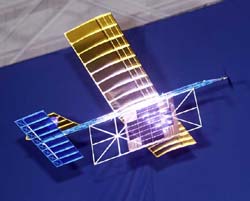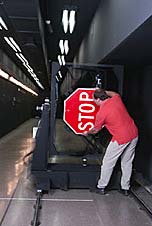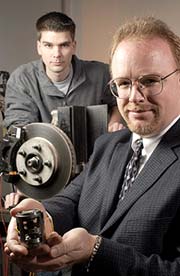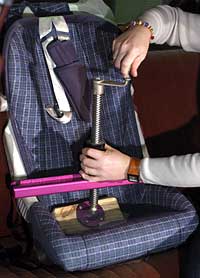
A tiny electronic device which could prevent rail disasters will be showcased today – by scientists who created it less than a mile from where the railway revolution began.
Microlog, a highly advanced miniature data logger, weighs less than ten grammes and boasts a four megabyte memory, a powerful 16 byte microprocessor and satellite and mobile phone technology packed into one third of the size of a matchbox.
It has been developed by a father and son team at the University of Newc

45th Annual Meeting of the Division of Plasma Physics
MIT physicists will report a new advance with the plasmatron, a small device that converts part of a fuel into a hydrogen-rich gas that reduces the emission of pollutants from vehicles. Developed by MIT researchers, the plasmatron was tested on a diesel-engine bus in Columbus, Indiana. The bus was tested by a team of engineers from ArvinMeritor, a major automotive and heavy truck components manufacturer which has licensed the plas

Scientists have long known of the potential risk from cosmic rays and other aspects of space weather, such as streams of protons from the Sun, to airline electronic systems, passengers, and crews. It has not been feasible to quantify this risk, however, as systematic data are lacking on the actual amount of rays and the charged particles and neutrons they create in Earth’s atmosphere that are encountered during typical flights. Researchers have now begun collecting that information, thanks to a

ATLANTA – Song™, Delta Air Lines’ new low-fare air service, has reduced the time that arriving aircraft return to service to 45-50 minutes, significantly shorter than the industry standard, according to a paper being presented at the annual meeting of the Institute for Operations Research and the Management Sciences (INFORMS®)
“To passengers, this means that they’ll be able to access more flights per day, so there will be greater frequency and more convenience,” comments

On 19 October 30 cars will be jostling for position at the start of the 7th World Solar Challenge in Darwin, Australia. After winning in 2001 with Nuna I, the Nuon Solar Team, from the Netherlands, will be bidding to retain their title.
The strong team of twelve from Delft University of Technology and Erasmus University Rotterdam are determined to beat the world record and try to average 100 km/h, compared to 91.81 km/h in 2001. Nuna II uses advanced space technology, provided to the team th

Ever since the dawn of powered flight, it has been necessary for all aircraft to carry onboard fuel — whether in the form of batteries, fuel, solar cells, or even a human “engine” — in order to stay aloft.
But a team of researchers from NASA’s Marshall Space Flight Center in Huntsville, Ala., NASA’s Dryden Flight Research Center at Edwards, Calif., and the University of Alabama in Huntsville is trying to change that.
They have now chalked up a major accomplishment… and a

Assisted by VTT Technical Research Centre of Finland, PKC Group, Finland works to develop bus technology applications for use in the power distribution and control systems on commercial vehicles. The concept is to offer customers flexible intelligent features while reducing the amount of wiring. The new LIN (Local Interconnect Network) technology was recently deemed to be the most promising technology to fulfil vehicle manufacturers’ new technological specifications.
To succeed in compe

Death and taxes may be unavoidable, but road tolls and car insurance could be made fairer if satellite-assisted distance pricing is implemented.
The European Space Agency (ESA) is funding Irish provider of location technology products Mapflow to undertake a feasibility study to look into the possibility of implementing a pan-European road tolling system. The research aims to establish whether satellite technology can be used to calculate the cost of motoring.
A plan exists to

Repairing our roads when and where it is needed was the goal for EUREKA project GEOSECMA-PMS. The project team created a complete software ’’toolbox’’ for municipalities and road authorities to assist them in the maintenance of roads and streets, thereby providing a safer, more comfortable ride for the public and savings for local government.
Hans-Goeran Wilhelmsson, chief executive of KORDAB, lead partner in the project, says the results have benefited citizens as well a

Our roadways should get safer in the future, now that the National Institute of Standards and Technology (NIST) has developed a way to accurately and reliably measure how light reflects off stop signs and other road markings.
Road signs and markings are designed to be visible at night by retroreflectivity—that is, they reflect some of the light emitted by a vehicle’s headlights back toward the driver’s eyes. However, measurements of retroreflectivity have varied so much among different devic

Swift or safe? That may be the question drivers with navigation systems ask themselves in future.
A new study by researchers at the University of Toronto Intelligent Transportation Systems (ITS) Centre and Testbed suggests in-car systems, designed to guide drivers around traffic jams and accidents quickly, could actually cause a temporary surge in the risk of accidents. “Discovering that traveller information systems may be good for travel time but not for overall safety was shocking

RIT study analyzes impacts of future transportation
Move over gas-guzzlers. The year is 2025 and 50 percent of all vehicles are electrically powered. Hybrid electrics, pure electrics and fuel cell vehicles share the road with the conventional gasoline-driven variety.
A recent study by James Winebrake, chair of public policy at Rochester Institute of Technology, analyzed this hypothetical transportation future and found economic benefits exceeding billions of dollars annuall

Squealing brakes cost auto manufacturers several hundred million dollars a year in warranty repairs and are among consumers’ top 20 vehicle complaints – even in luxury cars. Now, acoustics researchers at the Georgia Institute of Technology have developed a solution that could stop the problem of noisy brakes once and for all.
In disc brakes, squeal can occur when the brake pads contact the rotor while the vehicle is moving at low speeds, setting up a vibration that manifests itself as an an

Car owners of the future could one day swap petrol for environmentally-friendly alternatives, thanks to a multi-million pound research project involving academics at The University of Nottingham.
Researchers from the University’s School of Chemistry and School of Mechanical, Materials, Manufacturing Engineering and Management are developing new materials for hydrogen storage and for use in fuel cells that can use hydrogen as a clean alternative to oil and natural gas.
If new ma

Low-tech ‘Main Squeeze’ compresses for snug fit inside vehicle
Three Johns Hopkins University undergraduates have invented a low-tech tool that makes it much easier to properly install child safety seats in automobiles, ensuring a snug fit and maximum protection for the child.
The device, dubbed “Main Squeeze,” is intended to simplify the difficult task of compressing a child safety seat against a car’s permanent seat during installation. Incorrectly installed, a loose

EUREKA project LOGCHAIN E-W-LAND-BRIDGE is an ambitious multi-national project to establish an inter-modal inland link as an alternative transport route between the Adriatic Sea and southern Germany to the existing 5,000 km sea journey.
It is envisaged that this link, the “land bridge”, will be an integrated system utilising rail, road and inland waterways such as the Main-Danube canal. This connection will provide essential extensions to the northern European rail and road transport corrido